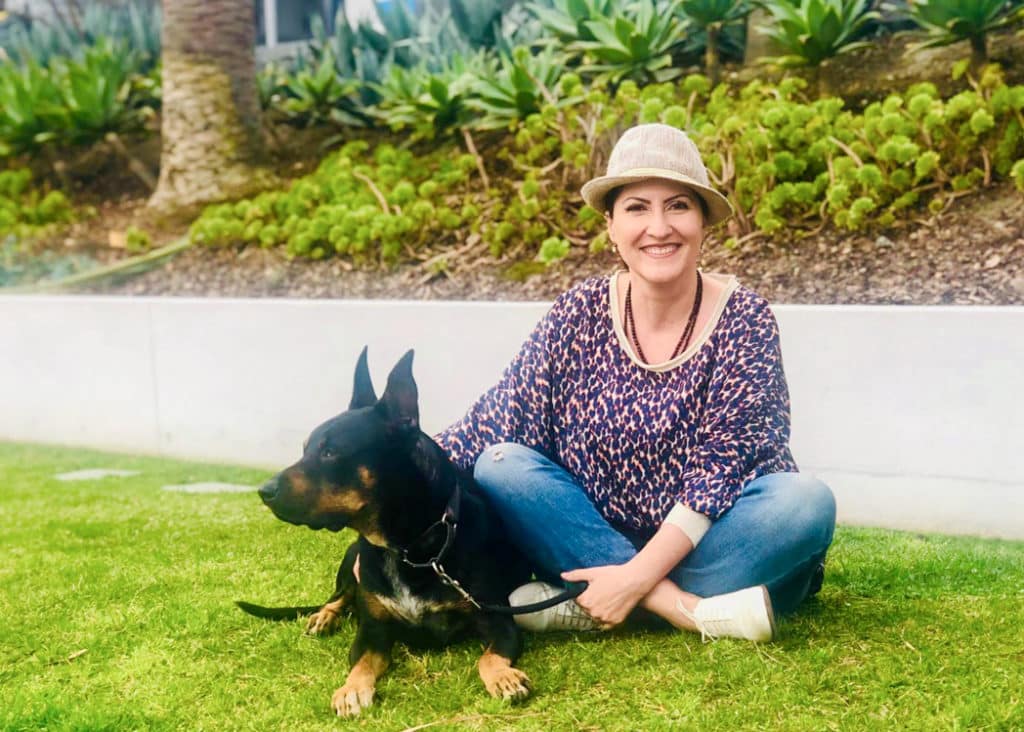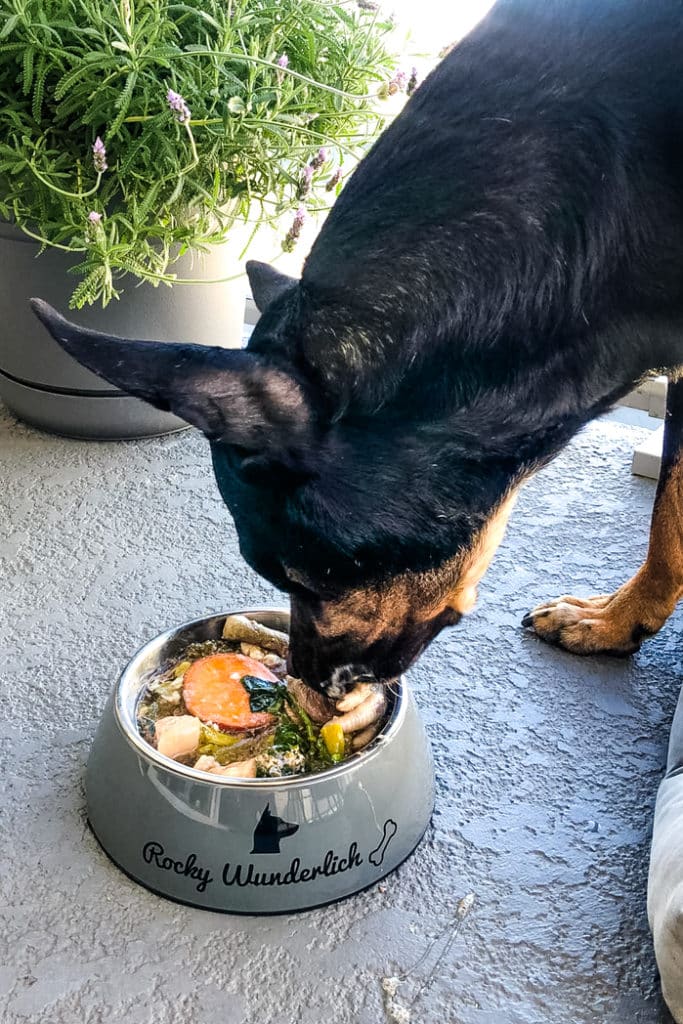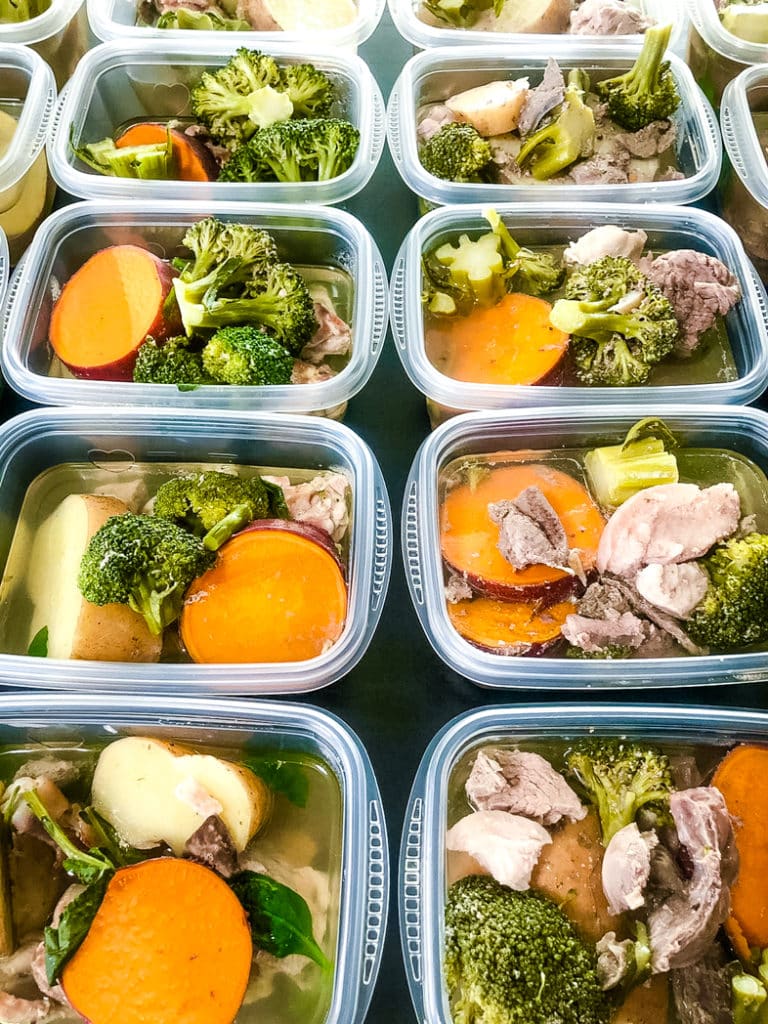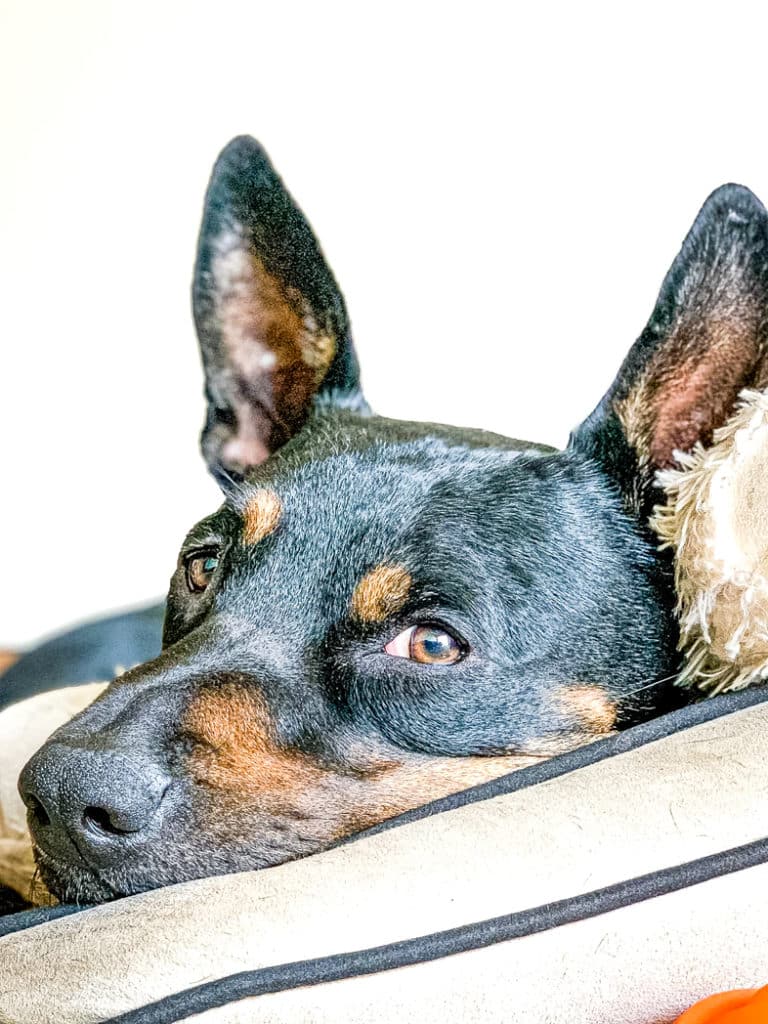The alarming cancer rates among pets have turned many eyes toward the potential hazards of processed foods. Sadly, over six million dogs and six million cats are diagnosed with cancer annually, igniting concerns about the correlation between pet food and this devastating disease.
The journey to healthier feeding options begins with exploring homemade dog food and meal prep, a regimen Cristina Wunderlich, a health coach and animal lover, swears by for her dog, Rocky.
Heavily processed foods adversely affect both humans and animals alike. Most store-bought pet foods often contain ingredients that are far from ideal for a dog’s diet, prominently grains, a common component in dry dog food.
Cristina generously accepted my invitation to give us a sneak peek into her dog’s healthy diet, ready to unveil not just one of Rocky’s favored homemade dog food recipes but also to impart insightful information on optimizing a dog’s diet for better health.
The Shift to Real Food
Cristina’s transformation into a dog food meal prep enthusiast was inspired by Hans-Ulrich Grimm’s book, “Cats Would Buy Mice.” Advocating for a natural, lectin-light diet for both humans and pets, Cristina believes in the benefits of specie-appropriate, real, wholesome food for pets.

Preliminary Steps: Allergy Testing
Embarking on this journey requires a thorough understanding of your dog’s dietary needs and restrictions. An allergy test, available online or through your vet, can pinpoint specific allergies, ensuring a tailor-made, nutritious diet for your furry friend.
Not Safe for Dogs: What Foods Can Dogs Not Eat?
Certain foods like avocados, eggplants, raw pork, and sweets are detrimental to dogs’ health. Similarly, alliin-containing foods like onions and garlic, as well as strongly salted or spicy leftovers, should not be part of a dog’s diet.
This is a list of foods generally considered not safe for dogs, so make sure they are not part of their diet:
- Avocado, eggplant, tomatoes, potatoes (cooked potatoes are fine)
- Legumes (beans, peas, etc.)
- Grapes, raisins
- Leeks, onions, garlic
- Paprika and paprika spices, mushrooms, pepper, chili
- Raw pork (cooked is fine)
- Sugar, sweets, chocolate, cacao, coffee, alcohol
- Leftovers from foods prepared for humans
Crafting a Balanced Diet for Your Dog
A dog’s homemade meal should encapsulate a variety of nutrients. A blend of meat, low lectin carbohydrates like sweet potatoes, vegetables, fruits, healthy oils, and herbs, creates a balanced diet.
Grains, unfortunately found in most brands of dog food, are not an appropriate food for dogs.
Protein
Dogs, being omnivores, thrive on a diet enriched with regular servings of meat and fish. While most animal proteins, excluding pork, can be offered raw, poultry stands out as a particularly beneficial option for a canine’s diet. The merits of a raw diet, rich in quality protein, are widely acknowledged as optimum for a dog’s health.
However, practical considerations, including cost, can be a deterrent, particularly for owners of multiple or large dogs. If an all-raw diet proves unfeasible, incorporating occasional servings of raw meat can still impart significant health benefits.
Minced meat and offal, including the heart, are nutrient-dense options. Rumen, game, liver, and lungs offer not only variety but also a nutritional boost. However, caution is advised with offal like liver and kidneys; while nutrient-rich, they should be limited to weekly treats to avoid overconsumption.
For those with dietary sensitivities, sheep’s meat is a digestible, allergy-friendly option. It’s crucial to avoid offering cooked bones to avoid the risk of injury.
If you dog loves it, fish is rich in phosphorus, iodine, and omega-3 fatty acids. Boneless fish fillets are the go-to, ensuring safe consumption without the risk of choking.
Eggs, a powerhouse of essential vitamins and minerals, contribute to a dog’s lustrous coat. However, moderation is key to prevent potential digestive issues – a couple of eggs per week suffices.
A pro tip for the environmentally conscious owner: salvage and bake the eggshells to eliminate the potential risk of salmonella, then grind them for a calcium-rich food supplement, ensuring they are untreated and safe for consumption.


Dairy
Many dogs are lactose intolerant but still like cheese and yogurt. This is because aged or fermented dairy has less lactose, the sugar found in milk, making it easier for them to eat.
If you want to give your dog dairy, it’s best to stick to small amounts of cottage cheese, yogurt, or hard, matured cheeses like Cheddar or Gouda. These can be good for your dog’s bones and help with digestion. Personally, I only give my dog a little cottage cheese once in a while.
Vegetables and Healthy Oils
Vegetables are just as healthy for dogs as they are for you, and healthy oils are essential for nutrient absorption.
Sweet potatoes, carrots, broccoli, celery, parsnips, and types of cabbage such as kale, savoy and Nappa cabbage, Brussels sprouts or chard, fennel, and beetroot – all taste delicious and are great to add to your dog’s meals.
You must puree the vegetable side dish or cook it well because your four-legged friend cannot split plant cell walls on their own – they have to be broken down mechanically. Only then are vitamins and minerals are absorbed.
Healthy oils such as linseed oil, hemp oil, walnut oil, and extra virgin olive oil are essential to absorb the fat-soluble vitamins.
Safe Fruits and Veggies
- Fruits considered safe for dogs: apples, pears, bananas, pineapple, peaches and nectarines (without the pit), berries of all kinds, kiwi, melon
- Vegetables that are considered safe for dogs, even when raw: carrot, parsnip, parsley root, cucumber, zucchini, fennel, chicory, celery, Swiss chard, beetroot, kohlrabi, lettuce, arugula, asparagus, spinach, cress, and sprouts. If you want to avoid lectins in food as much as possible, consider peeling and deseeding the zucchini and cucumber.
- Vegetables considered safe only when cooked: potatoes, sweet potatoes, cauliflower, Brussels sprouts, broccoli, Savoy / Napa cabbage, kale, chard. Consider replacing regular potatoes with sweet potatoes if you want to keep your dog on a lectin-light diet.


Grains, Rice, and Lectins
Cristina used to feed Rocky rice and quinoa, but she eliminated grains and pseudo-grains from his diet after learning about lectins, proteins found in plants that can damage the digestive system of both humans and dogs.
Unfortunately, many store-bought dog food brands are lectin-heavy, and they all contain grains.
Also, dogs get much of their energy from proteins and fats, and less from carbs.
Cristina’s Insight: What Goes Into a Dog’s Homemade Meal
When making homemade dog food, use this mix: half should be meat, a quarter can be low-lectin carbs like sweet potatoes or parsnips, and the final quarter should be fruits and non-starchy veggies. You can also add a bit of oil and herbs for extra flavor and nutrients.
Be careful with salt. A small amount is okay (1g of salt to 100g of food is generally considered safe), but it’s always best to ask your vet how much is safe for your dog. If you’re looking to cut down on carbs that are starchy, like potatoes, add more meat or non-starchy veggies instead. Even though dogs like these carbs, they are naturally meat-eaters and need a diet high in protein and fat.
Before you start cooking for your dog, find out how many calories they need each day. There are tools online that can help with this. Rocky, for instance, needs about 1,200 calories a day because he weighs 60 pounds and is moderately active. Treats and the oils in his food also count towards these daily calories.
I usually cook big batches of food to make meal times easier. When it’s time to eat, I mix in extras like different oils, herbs, or even half a can of tuna or sardines to make the meal tasty and nutritious. And for a complete meal, I add a healthy and nutrient-dense food topper, ensuring he receives all the necessary nutrients.


Prepping Homemade Dog Food
I’ve found a rhythm in preparing my dog’s meals every 2-3 weeks, making daily feeding a breeze. A 12-quart pot is my go-to, large enough for batch cooking. While premium grass-fed or organic meats are ideal, budget constraints lead me to more affordable options.


Shopping and Cooking
My shopping trips are guided by availability and affordability. The goal is optimal nutrition within budget constraints.
Preparing lectin-free dog food is uncomplicated. Ingredients go into the pot, are covered with water, and cooked until the veggies, especially the sweet potatoes, are tender. Spinach, however, is my exception – it goes in raw, layered under the cooked mix to gently steam from the residual heat.


Storing and Serving the Meals
Once cooked, I let the food cool before freezing it. I use reusable plastic containers with lids and every container is about 24 oz. Alternatively, you can freeze your homemade dog food in Souper Cubes.
Every meal is thoughtfully thawed in the fridge two days ahead of serving. A drizzle of oil or a sprinkle of food toppers elevates each serving, adding flavor and nutritional variety.


Sample Meal Batches
Here are two examples of my batch mixes, each yielding 15 meals stored in 24-ounce containers.
Batch 1:
- 2 large sweet potatoes
- 4 heads of broccoli
- Half a bag of spinach
- Chicken meat and feet (for collagen) + Gizzard + Some beef liver (aprox. 7 lbs)
Batch 2:
- 2 large sweet potatoes
- 4 heads of broccoli
- Half a bag of spinach
- Chicken feet + Beef and some beef liver + Pork (aprox. 7 lbs)
Each ingredient contributes to a balanced, nutrient-rich meal, ensuring Rocky enjoys a varied and wholesome diet without the daily cooking hassle.
The approach is practical, the meals nutritious, and the process, though streamlined, is infused with care and consideration for optimal canine health.
What is a food topper?
We recommend a whole-food diet comprising homemade meals for your pup. However, ensuring they receive all the necessary nutrients can be challenging. That’s where food toppers or supplements come in.
A food topper typically combines multivitamins and minerals and is designed to be added to homemade meals, ensuring a balanced and complete diet for your dog.
Nutra Thrive: Canine Nutritional Supplement
Nutra Thrive™ is the first canine supplement of its kind — a comprehensive formula that combines powerful probiotics with easily absorbed nutrients, vitamins, minerals, antioxidants, and digestive enzymes. Together, these powerful ingredients help support your dog’s overall health:
- Nourish Skin and Coat: Vitamins, minerals, and antioxidants come together to soothe irritated skin and restore shine and luster to your dog’s coat.
- Promote Digestion: Powerful probiotics and digestive enzymes help support healthy nutrient absorption and smooth, worry-free digestion.
- Bolster Immune System: A unique blend of superfoods support a healthy immune system, which can help your dog live a long, happy life.
Nutra Thrive Food Topper
Nutra Thrive™ is a comprehensive formula that combines powerful probiotics with easily-absorbed nutrients, vitamins, minerals, antioxidants, and digestive enzymes.

For Further Learning about Dog Nutrition
There are two incredible podcasts that offer a great expert insight into dog’s nutrition:
- The Dr. Gundry Podcast, EP. 268, How to Feed Your Dog for Longevity, with Dr. Gary Richter, veterninarian, founder of Holistic Vet Care, and author of two books: ‘Longevity for Dogs’ and ‘Longevity for Cats’.
- The Dr. Gundry Podcast, EP. 181, with Dr. Karen Becker & Rodney Habib, authors of The Forever Dog: Surprising New Science to Help Your Canine Companion to Live Younger, Healthier and Longer.
For more lectin-free guides and articles, click HERE.
*This post contains affiliated links, which means I get a small commission if you choose to purchase something via one of my links, at no extra cost to you
Print
Healthy Dog Food Meal Prep (Lectin-Free)
- Prep Time: 20 minutes
- Cook Time: 20 minutes (up to 30 minutes)
- Total Time: 40 minutes
- Yield: 15
Description
Your furry friend deserves nutritious, healthy food as much as you do. Learn a few simple tricks about how to easily prepare lectin-free dog food at home.
Ingredients
- 7lbs / 3.1 kg mixed meat: chicken meat, chicken feet, gizzard, beef liver (you can add beef and pork to your mix)
- 2 big/giant sweet potatoes, cut in big chunks
- 4 broccoli heads, cut in florets
- good quality salt (it’s considered safe to add about 1g of salt to 100g of food, but consult with your vet to decide how much salt your dog needs; there are 5g of salt in one teaspoon)
- water to cover
- 8oz fresh spinach
- extra virgin olive oil, flaxseed oil, for serving
Instructions
- Add the meat, sweet potatoes and broccoli to a 12qt soup pot and cover with water.
- Boil until the potato is cooked, about 20-30 minutes (remember, the potato needs to be well cooked).
- Prepare your storage containers and add a handful of spinach to each container.
- When the soup is ready, let it cool a little bit as you don’t want to add a too hot content to plastic containers.
- Once filled, let cool completely, cover and freeze (don’t forget to leave a little space as the volume will increase when frozen).
- Take out and thaw in the fridge a day in advance.
- Drizzle some healthy oil, add a food topper if you need and serve.

4 Comments
Ruth
February 19, 2025 at 2:09 amThank you so much for this recipe! Your dog is so lucky to have such a thoughtful and amazing cook as owner. This for sure will spoil my dogs when they feel meh about their dry foods. Please don’t let the rude criticism discourage you, I was very surprised to see such rude comment at the end of the article because it was not what I was thinking while reading at all!!! I wonder how many online recipes AND published chef’s recipes for humans are nutritionist and doctor approved.
Claudia
February 19, 2025 at 3:55 amHi Ruth! Thanks so much for the kind words. Yes, imagine if each recipe we cook or share would be nutritionist approved. But these guideline are inspired by veterinarians and pet diet experts (those who published the books I mentioned, and the discussions on podcasts, so it is informed by expert advice). And of course, it’s just a guideline, every pet is different and have their own problems or preferences. xx
Dr. Mel
April 16, 2024 at 5:03 pm*This author is NOT a veterinary nutritionist. The only way to make a homemade diet for your dog long-term is to consult with a veterinary nutritionist (not a regular vet)- this is to prevent malnutrition and deficiencies, which are incredibly common with these online diet recipes from a lay person. Your dog also needs to have bloodwork done every 3-6 months to ensure they are not getting too much or too little of certain vitamins. 95% of homemade diets require added supplements to meet basic nutritional requirements for a dog. Bottom line: talk to a nutritionist and do the bloodwork. Don’t blindly trust some online recipe from someone with no education in this field. Every dog is different and may require tweaks in their diet. If you love your animal, you’ll take the professional route to prevent risks to your dog’s health. If this woman cares about your animals, she’ll leave this comment so people know how to safely feed their dogs.
Claudia
April 18, 2024 at 4:00 amThank you for your concern and for emphasizing the importance of professional guidance in preparing homemade diets for pets. I appreciate your points and agree that consulting with a veterinary nutritionist is ideal to ensure a balanced diet tailored to an individual dog’s needs. I’d like to clarify that our article does indeed mention the necessity of testing and consulting with specialists. We understand that access to a veterinary nutritionist is a privilege only for a few people who can afford it and also have access to such a specialist, which is why we provide resources, like podcasts and books by reputable experts, to help our readers make informed decisions. Additionally, we recommend a high-quality food topper formulated by leading dog nutritionists to help address potential nutrient gaps. Our goal is to offer a starting point for pet owners who have a “food is medicine” approach to diet, but are new to dog nutrition and encourage them to seek further professional advice as needed. We are committed to the well-being of all pets and believe in empowering our readers with the best possible information.